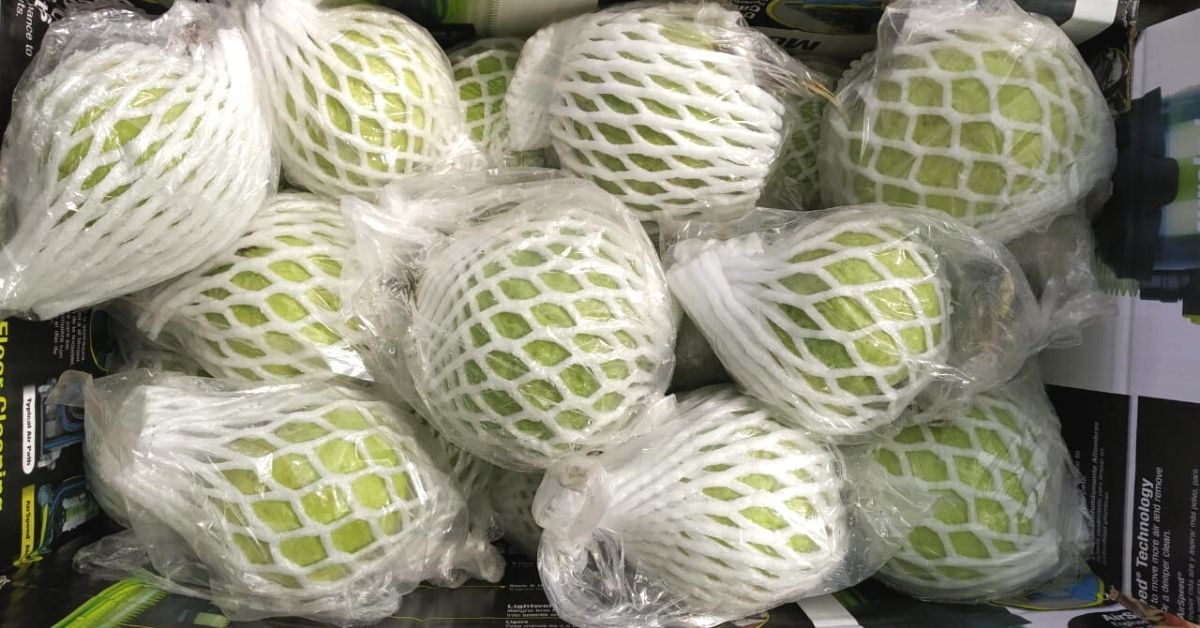Farmer Grows Thai Guava That Can Weigh Up To 1.4 Kilo, Earns Rs 32 Lakh/Year
Dinesh Baggad from Madhya Pradesh was a traditional farmer who switched to growing the Thai variety of guava on his orchard, earning him lakhs of rupees. These guavas are massive and extremely sweet, and Dinesh says they're easy to grow as well

A visit to Dinesh Baggad’s guava orchard in Madhya Pradesh will leave you spellbound at the sight of the hundreds of massive guavas hanging from the trees, which spread out across the expanse of the seemingly never-ending orchard.
But a few years ago, Dinesh’s farm was not the sight to behold that it is today. The farmer, who belongs to Sajod-Rajod village, used to traditionally grow chillies, tomato, okra, bitter gourd and other seasonal vegetables on his 4-acre ancestral land. However, a heavy infestation of pests and fungus, along with increasing labour costs, had reduced his profit margins and income.
“Market rates don’t increase much compared to the cost of production, and low profits over the years make farming economically challenging,” Dinesh, who was earning around Rs 7 lakh from traditional farming, tells The Better India.
A Fruit That Weighs 1.4 Kilos

In 2010, his friend suggested he try horticulture and introduced him to the Thai variety of guava. “The guava looked huge in the pictures and video. I also visited an orchard in the neighbouring state and was impressed, as each fruit weighed at least 300 grams and almost grew to the size of a muskmelon,” he says.
“The variety is called VNR-1, and I learned that the fruit had a longer shelf-life by six days and was less susceptible to infestation. The long shelf-life means that even far-located markets can be accessed. Considering it as a profitable prospect, I decided to experiment with the same,” he explains.
Today, Dinesh has 4,000 plants in his orchard, which earn him Rs 32 lakhs. Taking inspiration from his success, about 400 farmers in Madhya Pradesh have also followed suit.
Dinesh notes, “Initially, I had doubts that the fruit variety had been injected with hormones or some chemicals to achieve their massive size. But after planting a few at my farm, I received my first fruiting in 11 months by following conventional farming techniques. The biggest fruit weighed 1.2 kilos.”
He adds that he then leased 18 acres of land with his brothers to plant 4,000 trees in 10 years. His income has increased fivefold over the years and brought much needed financial relief, he says.
“I sold the fruit at Rs 40-50 per kilo and produced 65 tonnes in 2021. Each fruit weighs between 400 and 1,400 grams, attracting customers with its size and sweet taste,” he says.
Dinesh says that he was one the first to grow these guavas in the region successfully.
He adds that though his decade-long perseverance has brought him success, marketing the fruit was the biggest challenge before him.
Changing The Market Demands

“The trees require minimum maintenance and demand less attention, but when I began marketing the fruits, it became a problem. Many people were sceptical about buying the guava for its massive size, and felt like it would be too much to consume a kilo in one go,” he says.
Dinesh realised that venturing into the new sector of horticulture demanded a different market altogether.
“I tried to sell my produce at 12 market places across India, including Bhilwara, Jaipur, Udaipur, Ahmedabad, Vadodara, Surat, Pune, Mumbai, Bengaluru, Bhopal, Delhi and others,” he says, adding that he saw his first success in 2016, when he sold guavas at Rs 185 per kilo in Mumbai. “I realised that customers in Delhi and Mumbai appreciated the fruit, and I started targeting specific markets,” he adds.
Dinesh plans to expand his plantation by an additional five acres in the coming year. “I wish to enter food processing to make products from guava, but I do not have the capital and know-how. The plantation will benefit me for the next 10 years,” he says.
He also aims to experiment with Red Diamond, a seedless variety of guava. “I have recently learned about it and hopefully it will be in demand soon,” he says.
Edited by Divya Sethu
If you found our stories insightful, informative, or even just enjoyable, we invite you to consider making a voluntary payment to support the work we do at The Better India. Your contribution helps us continue producing quality content that educates, inspires, and drives positive change.
Choose one of the payment options below for your contribution-
By paying for the stories you value, you directly contribute to sustaining our efforts focused on making a difference in the world. Together, let’s ensure that impactful stories continue to be told and shared, enriching lives and communities alike.
Thank you for your support. Here are some frequently asked questions you might find helpful to know why you are contributing?


This story made me
-
97
-
121
-
89
-
167











